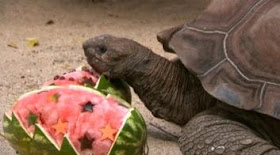Storybook Farm provides a secure home for animals with disabilities, injuries and special needs.
 |
| Storybook Farm provides a home and care for injured animals. |
Storybook Farm provides a home and care for injured animals.
A little farm with a big heart is helping three-legged dogs, blind horses and anxious donkeys live long and happy lives.
Storybook Farm, in south-east Queensland, houses animals of all shapes and sizes with special needs on a small plot of land in the Scenic Rim.
Lisa Jane Cameron along with her family have been helping animals for more than 30 years.
The one-of-a-kind farm began after their family dog, Mr Waddles, became paralysed and they could not find a support service for disabled animals.
“Since then we’ve welcomed brain-damaged whippets, Matthew a blind staffy and Krumb our wheelchair-bound dachshund,” she said.
“If the animals have the will, we will find a way and that’s what it’s about.”
A passion for problem solvingIt is not just the animals that Ms Cameron has to assist.
Owners of the animals turn to her for emotional support too.
“Our main aim is to keep families together where possible, and if not we visit the families with their pet,” she said.
“For many of the people we help their pet is the only living thing they have seen all day and if you remove that it’s detrimental to the person as well.
“We’ve seen families who thought it was the end and they were traumatised families and now they are back together again.
“We do it because we love it and we want to help.”
 |
| One of the goats is being nursed back to health after breaking his leg. Photo: ABC |
The small sanctuary focuses on giving a new lease on life to special needs animals and also severe cruelty cases.
“We’re developing wheels that can be used on the beach [for disabled dogs],” Ms Cameron said.
“With the blind dogs, we’ve learnt to place furniture in the right places and we teach them about different sounds.
“For the dogs that can’t walk we have drag bags and we’re inventing better ones that are cooler for Queensland – we’re problem solvers and we do it every day.”
 |
| Krumb the dog is one of the well-known characters on the farm. Photo: ABC |
Helping animals with a strong will to liveMs Cameron has been called many things including Molly from A Country Practice and Doctor Doolittle.
She sees her work as a way to give back to the community – and to animals too.
“Animals do so much for us, they protect us, they’re therapy dogs, they help us see and help with cancer patients,” she said.
 |
| LJ Cameron holds one of the whippet dogs who has an injured skull. Photo: ABC |
“People’s blood pressure lowers when they pat a cat and nursing homes are better with an animal in it.
“We’re not here to save all animals but if they have a strong will to live we will give them a way.”
Ms Cameron’s children, Alex and Jonah, help on a daily basis with feeding, walking and working closely with each of the animals.
“I couldn’t do it without my children,” she said.
“It has taught them to respond. It makes them better people as they are more compassionate, tolerant and they have understanding.”
Making a differenceWhen people ask Ms Cameron why she does what she does, she tells them that she wants to make a difference.
“You get up and you make a difference, as I think that’s what we’re here for,” she said.
“I think we owe the animals more than they owe us.
 |
| Alex Cameron nurses one of the blind goats on the farm. Photo: ABC |
“We find many people find the dogs confronting, especially the dogs
in wheelchairs – as they see the wheelchair, not the dog in the
wheelchair.
“I let people spend time with them and within minutes people are in tears.”
 |
| The blind dogs on the arm have collars detailing their vision-impairment. Photo: ABC |
The future for Storybook FarmIn the future, Ms Cameron hopes to bring literacy and her animals together with storytelling sessions for children to be held at the farm.
She also hopes to register Storybook as a charity in 2016 and find more people to come onboard and help.
“Inside each bit of fur, feather or scale there’s a someone and it’s not a Disney-fied sort of attitude,” she said.
 |
| One of the three-legged dogs running around the farm. Photo: ABC |
“My aim is to build the sanctuary and make it secure and strong enough that it’s a legacy that goes way past me.
“We hope to get a stable property to set-up a permanent base and we want to go to more schools and hospitals next year.”

















